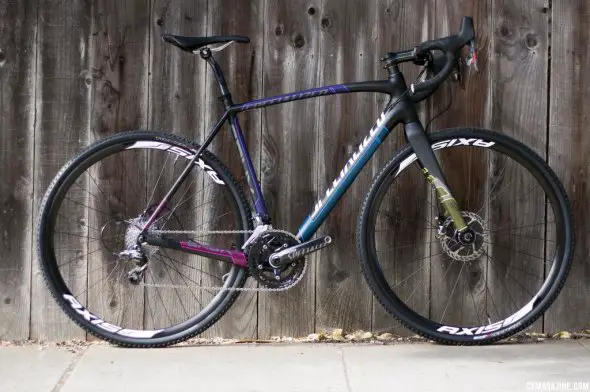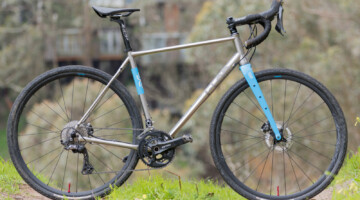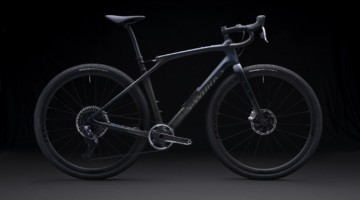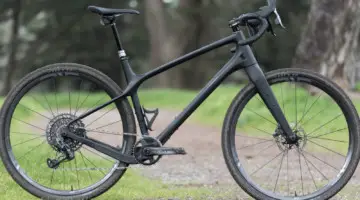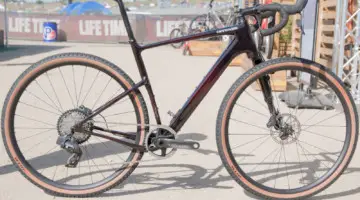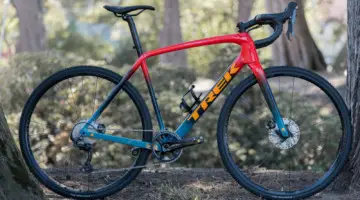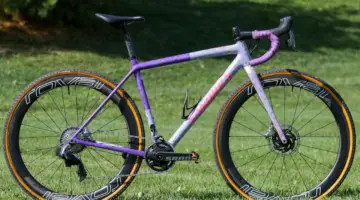Note: This is a 2014 bike review from last season’s Issue 23, and the brakes were recalled units since the test.
Grab a lightweight, dramatically-shaped carbon fiber frame, add neon highlights, embrace the latest braking technology and include two sets of disc brake wheels and what do you have? The $6300 2014 Specialized CruX Pro Race Disc.
That price tag alone will scare off many people from reading further, but thankfully, Specialized still offers four lower-priced carbon models, including the $4200 Expert RED Disc and the $3200 Elite Rival and Elite EVO Rival sister bikes, all of which share the same frame as the Pro Race. Not sold on discs? Specialized still offers the $2450 canti-equipped Sport 105 model (see Issue 19 for our review of that frame).
The really unique thing about the CruX Pro model, and the even more expensive S-Works model above it, is that the bike comes with two wheelsets. Do two wheelsets mean double the fun?
The Frame
Specialized makes four versions of its carbon CruX: two disc brake models, and two cantilever models. Each brake configuration comes in two different carbon fibers. There’s an S-Works model, with the company’s higher grade, lighter FACT 11r carbon fiber, while the other models use the FACT 10r carbon. The weight difference? Approximately 200g for the frame. Specialized said their S-Works models are just under 1000g, and the disc models are actually a tad lighter than the cantilever brake-bossed versions.
Specialized isn’t afraid to stray from standards to build what it thinks is a better bike. The company eschews the standard 1-½” lower bearing and instead uses a 1-⅜” bearing, making its cyclocross fork a proprietary item.
A year ago we got to visit Specialized and learn more about the construction and testing of the CruX line of bikes, and it’s fair to say that Specialized has some advanced testing facilities that a typical small importer of Asian-made carbon frames may not have access to. Such testing included fatigue and deflection tests, and regardless of the value you place on such equipment and testing process, it’s one of the things you’re paying for when buying a Specialized.
The CruX’s frame includes all of the features that we’ve come to appreciate and expect from a modern, high-quality carbon cyclocross frame. There’s a flattened top tube for shouldering comfort, generous tire clearance behind the bottom bracket without a horizontal shelf for mud to collect on, 135mm rear spacing, fittings for electronic drivetrain wiring, and a versatile 27.2mm seatpost. Cables are internally routed, and the frame and fork are both set to use 140mm rotors. It’s a curious choice for Specialized to build their fork for 140mm rotors: While bikes seem split between 140mm and 160mm rotors in the rear, most use a 160mm in the front, as does this bike, but does so with a clunky adapter.
The bottom bracket is Specialized’s OSBB configuration, which on this frame is essentially a BB30 setup, and accepts BB30 cranksets (and others with adapters).
Look hard and you’ll find some nice touches, including the “LoveHandle” on the underside of the down tube, designed to enhance your grip when picking up the bike to shoulder it.
The Build
Specialized opted for a mix of 11-speed SRAM Force and RED for this bike, choosing RED HydroR levers and brakes, and Force derailleurs and cassette. It’s an effective combo, and by opting for the more affordable Force derailleurs, it will probably save a lot of ’crossers a lot of money to restore their bikes when they shred their rear derailleurs in some sticky mud.
Specialized uses their own branded handlebar, stem, seatpost and crankset. The stem offers four different angle adjustments, two via flipping the stem, and two more by rotating a shim that sits between the stem and the steerer. Like the handlebar, the stem isn’t the lightest, at 176g, but does offer the rider more fitting options. The carbon crankset comes with 36/46 rings, and is light, unique-looking and offers true cyclocross rings with decent shifting.
The really unique thing about this model, and the even more expensive S-Works model above it, is that the bike comes with two wheelsets. A heavy alloy, Axis 2.0 clincher wheelset comes for training purposes, while the Roval Rapide CL 40 Disc Tubulars are ready for race day. On one hand, we think it’s a brilliant move on Specialized’s part, especially since many jumping over to disc brakes won’t have race wheels already, and it really adds a convenience to the whole shopping experience, especially if your shop can throw in an expert gluing job in the process.
The biggest downside to the two wheelset offering? Price. But as we said, if you don’t want another pair of wheels, you might look a the Expert RED for a more affordable option, as it’s $2100 less. That should be able to buy you a very nice set of wheels.
Swapping wheelsets should be easy as pie, but it’s not a 30-second project for a race day morning. The tubular wheels do not come with another cassette, so you have to move that over or buy another. Also, the rotors on one wheelset may not line up perfectly with the other. On our test bike, they were spaced several mm different, requiring readjustment of the caliper mounting bolts and realignment the caliper: a minor pain if are expecting a quick change (or a major pain if you expect to use the clinchers as pit spares on race day). Yet one racer who we know with this exact bike has reported to have no issues with rotor alignment whatsoever in swapping between wheels. It’s just evidence how much product tolerances vary between individual bikes.
The Roval carbon tubulars rely on Centerlock rotors, while the Axis clinchers use the 6-bolt standard, making the rotors not interchangeable.
We think that perhaps the wheels should be an add-on option when buying the bike, and with all the great tubeless tire options now (including three from Specialized), a lightweight tubeless wheelset might be the only wheelset you need.
Ready for the bad news? The seatpost is the worst we’ve ever tested for cyclocross. We’re okay with carbon posts, and like Zertz for its slight damping qualities, but the one-bolt head of the post cannot securely hold the saddle angle in place. All it takes is a big bump or less-than-perfect remount to have the saddle pointing to the sky. Thankfully, changing a post is easy, and if you’re buying this bike, ask the shop to swap it out. If you’ve read any other review on this bike that doesn’t mention this flaw, they haven’t actually raced the bike in a cyclocross race. Also note that the curvature of the post limits how far you can lower the saddle into the frame, and we know of riders who had to replace the post just because of this design.
The Ride
The word crux can mean several things: a cross, or a decisive or pivotal point. Specialized’ aptly named CruX presents itself as a marvel of engineering to deliver all the above, based on looks, equipment, and reputation.
The ride of the disc-equipped CruX is very similar to the canti version that we reviewed (and loved) in Issue 19. First and foremost, we love the CruX geometry on our 56cm test model, with its low bottom bracket (69mm drop), short 42.5cm chainstays, and modestly steep 72-degree head angle create a race-ready package that offers a low center of gravity, great traction and quick steering, while still providing versatility to do dual duty as a road, gravel or winter bike with different tires. The steep head angle combined with the longer-than-typical 49mm rake makes for a pretty quick steering machine.
To read the full review, get your hands on a copy of Issue 23 of Cyclocross Magazine!
You can get a back copy of Issue 23 here, but if you can’t wait, there are plenty of digital options. Download our app from iTunes (here for the iPad version and here for the iPhone version) and subscribe for access to all the cyclocross content you can handle, or browse the Apple Newsstand to see what the latest issue holds.
For those Android-users out there, we have you covered with our app available in the Google Play store, so you’ll never have to glance longingly at your buddy’s iPad as he reads an interview with Jonathan Page or Lars van der Haar to get psyched up for a race.
And for those of you who want to read the magazine on your computer, your Kindle, or most other places, there’s Uberflip. Not only is it a cross-platform way to subscribe, Uberflip boasts (in addition to a standard subscription) our All Access Digital Pass, which allows you to read every single back issue of Cyclocross Magazine, so you can see how far we—and the sport—have come over the past few years.
Vital Stats:
- MSRP: $6300
- More Info: Specialized.com













